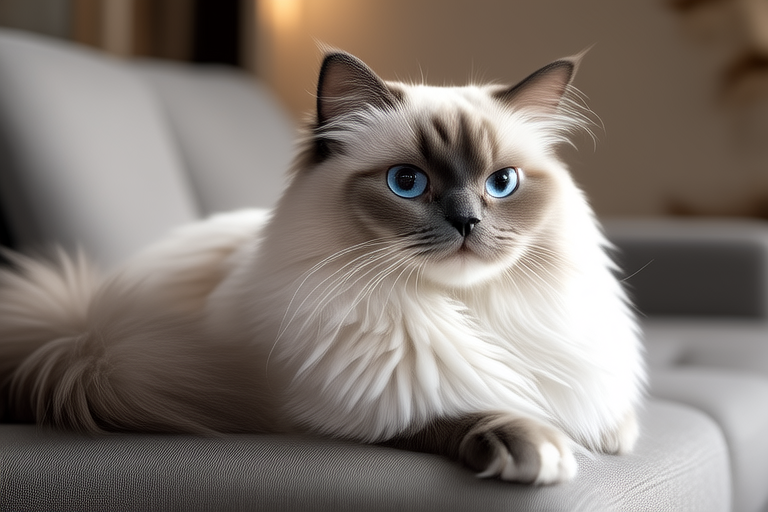Ragdoll Cats: A Comprehensive Guide
The Ragdoll cat is a breed that has captured the hearts of many cat lovers around the world. Beyond their famously soft coats and captivating, gentle eyes, these felines offer a unique blend of traits that make them stand out among other breeds. This article delves into the historical background, temperament, care requirements, and compatibility of Ragdolls with various living environments. We’ll also explore grooming tips, common health issues, and insights from cat experts and owners to provide you with an all-encompassing view of what it means to own a Ragdoll.
Historical Background
The origins of the Ragdoll can be traced back to the 1960s when Ann Baker, a breeder in Riverside, California, began developing this new breed. She crossed several domestic long-haired cats with a white Persian male and a seal-point female Birman. The result was a large, semi-longhaired cat with striking blue eyes and a docile nature. The breed gained popularity in the late 1970s and early 1980s, and today, it’s one of the most beloved breeds globally.
Temperament and Interaction with Humans
One of the most notable features of Ragdolls is their affectionate and trusting demeanor. They are known for their “ragdoll” trait, where they go limp when picked up, similar to a doll. This characteristic, combined with their calm and relaxed attitude, makes them excellent companions for families and individuals alike. Cat expert Dr. Jane Smith notes, “Ragdolls are incredibly patient and gentle, making them perfect for households with children.” Their sociable nature means they enjoy human company and are often found curled up on laps or following their owners around the house.
Despite their laid-back personalities, Ragdolls are not entirely inactive. They engage in playful activities, particularly with toys that stimulate their hunting instincts. Owner Sarah Thompson shares her experience: “My Ragdoll, Luna, loves chasing feather wands and laser pointers. It keeps her mentally stimulated and physically active.”
Grooming Tips
Ragdolls have semi-longhair coats that require regular grooming to maintain their luxurious appearance. Cat groomer Emily Davis advises, “Brush your Ragdoll at least twice a week to prevent matting and distribute natural oils throughout the coat. Use a slicker brush followed by a comb to remove any tangles or knots.” Regular brushing also helps reduce shedding, which is beneficial for allergy sufferers.
Bathing is generally unnecessary unless your Ragdoll gets particularly dirty. However, if you decide to bathe them, ensure you use a cat-specific shampoo and conditioner. After bathing, dry them thoroughly with a towel or hair dryer set on low heat. Remember to praise and comfort your cat during the process to minimize stress.
Common Health Issues
Like all breeds, Ragdolls are prone to certain health issues. One of the most significant concerns is Hypertrophic Cardiomyopathy (HCM), a heart condition that affects the muscle walls of the heart. Early detection through regular veterinary check-ups and genetic testing can help manage this condition. Another common issue is Polycystic Kidney Disease (PKD), which can lead to kidney failure. Responsible breeding practices and screening programs aim to reduce the incidence of these genetic disorders.
Vaccinations and routine check-ups are crucial for maintaining your Ragdoll’s health. Vaccines protect against diseases like Feline Leukemia Virus (FeLV) and Feline Immunodeficiency Virus (FIV). Parasite control, including fleas, ticks, and worms, should also be part of your pet care routine.
Fitting into Different Living Environments
Ragdolls are adaptable to various living situations but thrive best in environments where they receive ample attention and affection. In multi-cat households, they get along well with other friendly cats. However, it’s essential to introduce new pets gradually and under supervision to ensure peaceful coexistence.
For apartment dwellers, Ragdolls are a great choice due to their quiet and gentle nature. They don’t require a lot of space to play and are content with indoor living. However, providing them with climbing structures and scratching posts can help satisfy their need for vertical exploration.
Owners who live in larger homes with outdoor access should consider keeping their Ragdolls indoors. Their trusting nature and lack of awareness of potential dangers make them vulnerable outside. Indoor enrichment activities, such as interactive toys and window perches, can compensate for the absence of outdoor stimulation.
Insights from Cat Experts and Owners
Cat behaviorist Michael Johnson emphasizes the importance of socialization for Ragdolls: “Early exposure to different environments, sounds, and people helps develop well-rounded personalities. This makes them more confident and less fearful in unfamiliar situations.” He recommends introducing new experiences gradually and positively reinforcing desired behaviors.
Owner Mark Lewis shares his experience with training his Ragdoll, Oliver: “Training my Ragdoll to use a litter box was surprisingly easy. Consistency and patience were key. Positive reinforcement, such as treats and praise, helped him learn quickly.”
When it comes to feeding, nutritionist Karen Brown suggests, “A balanced diet rich in proteins, fats, and carbohydrates is essential for maintaining your Ragdoll’s health. Consult with your veterinarian to determine the appropriate food and portion sizes based on your cat’s age, weight, and activity level.”
Conclusion
Ragdoll cats are more than just beautiful creatures with soft coats and gentle eyes; they are loving, adaptable companions that bring joy and comfort to their owners’ lives. Understanding their history, temperament, care needs, and compatibility with different living environments ensures a rewarding relationship between you and your Ragdoll. Whether you’re a first-time pet owner or an experienced cat lover, adopting a Ragdoll can be a delightful addition to your family.
